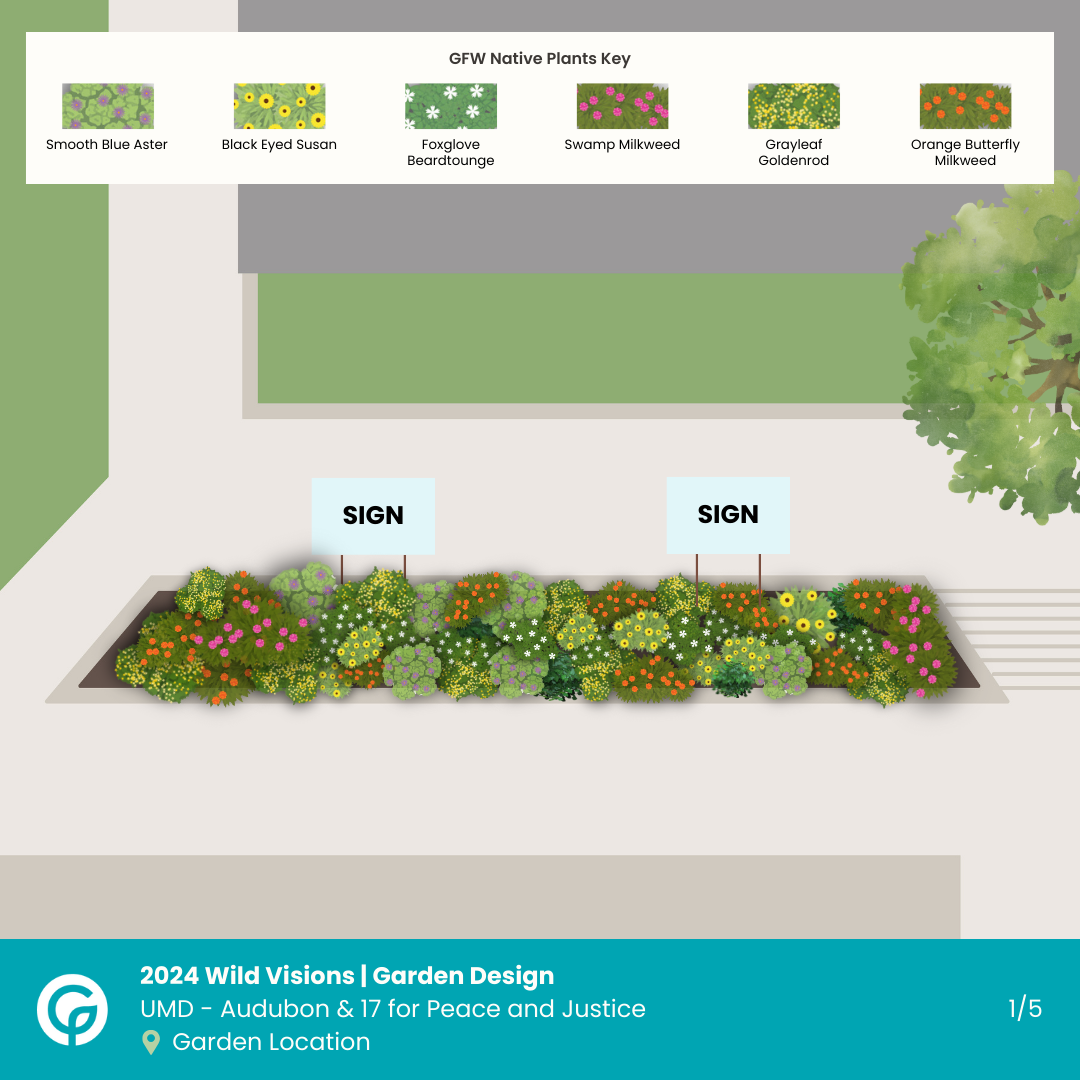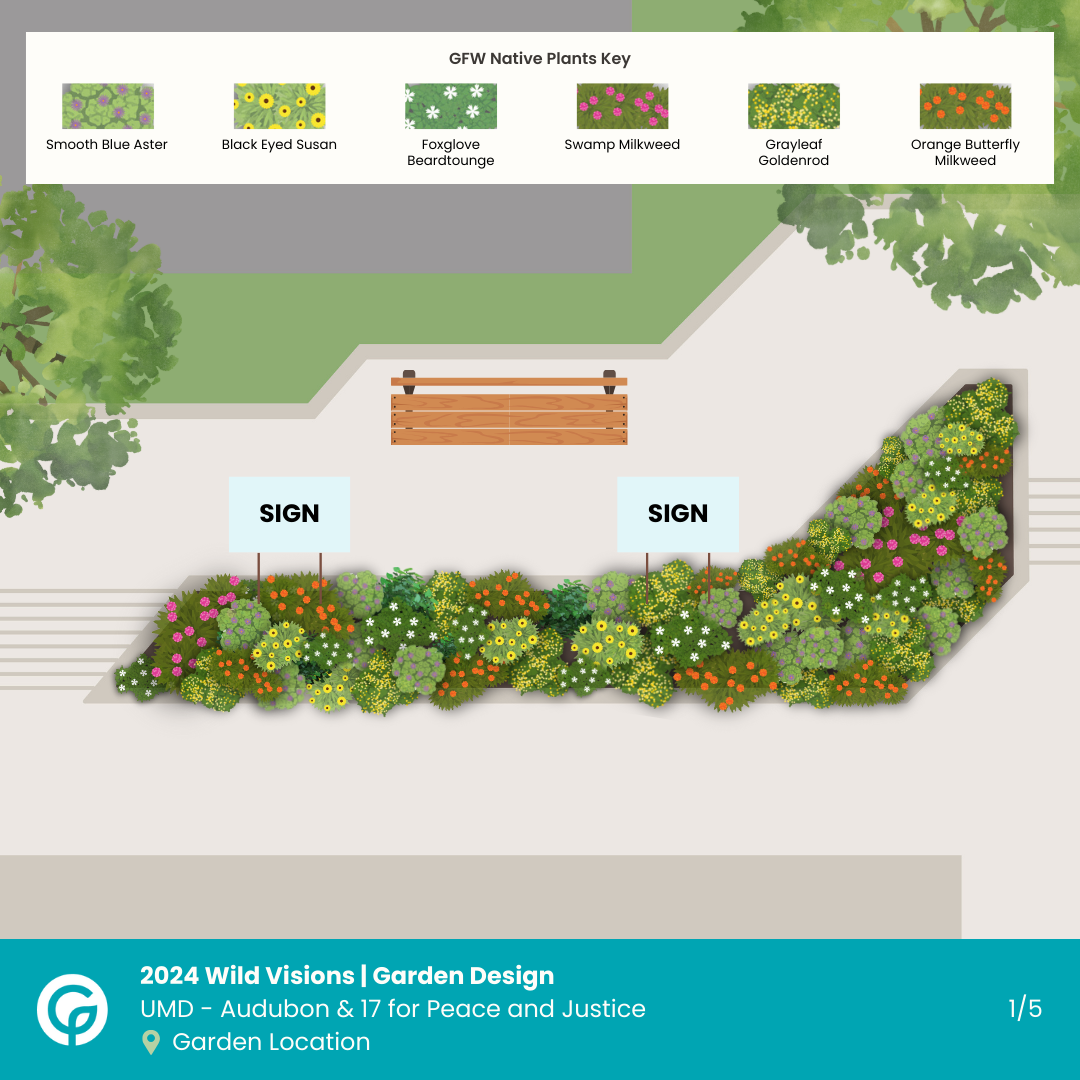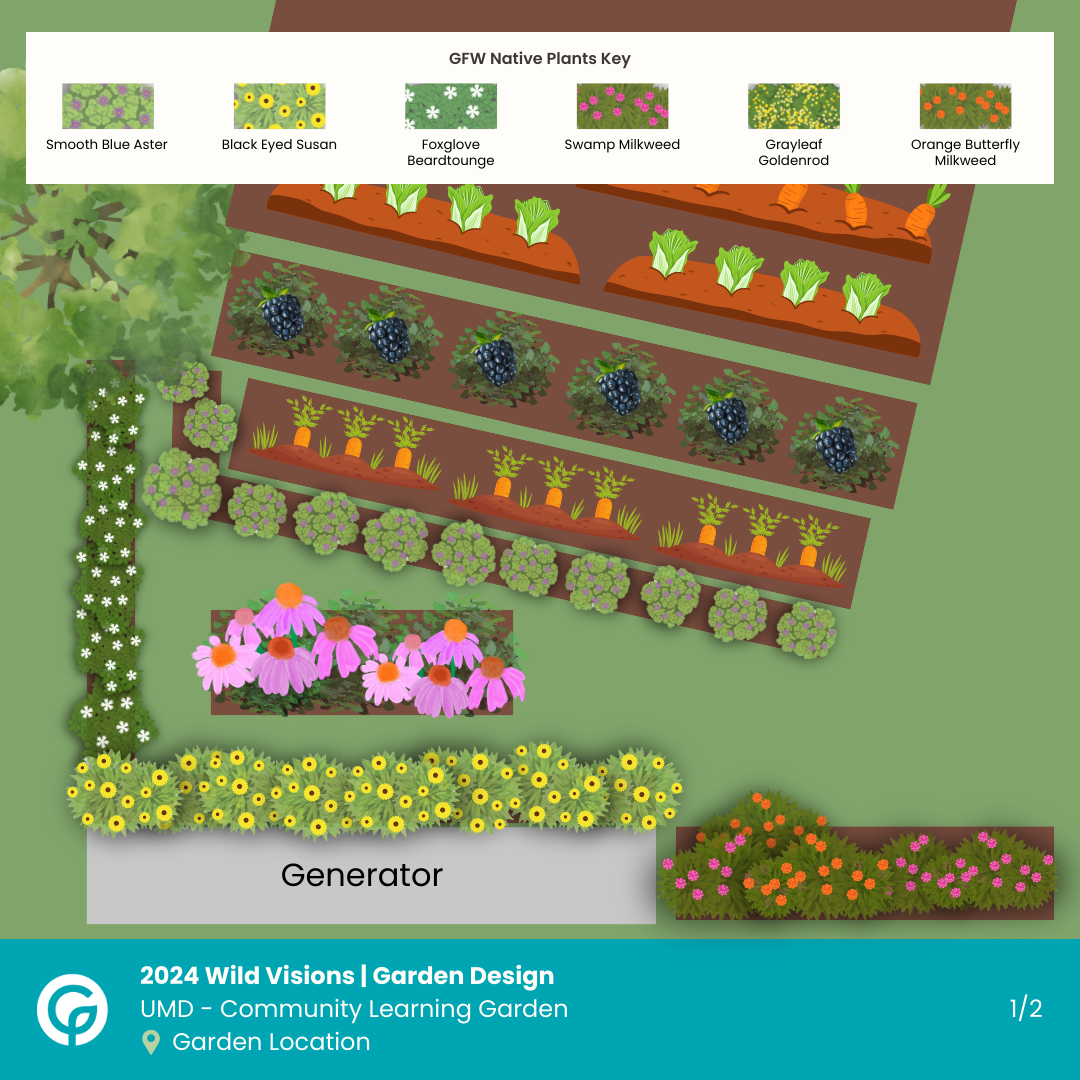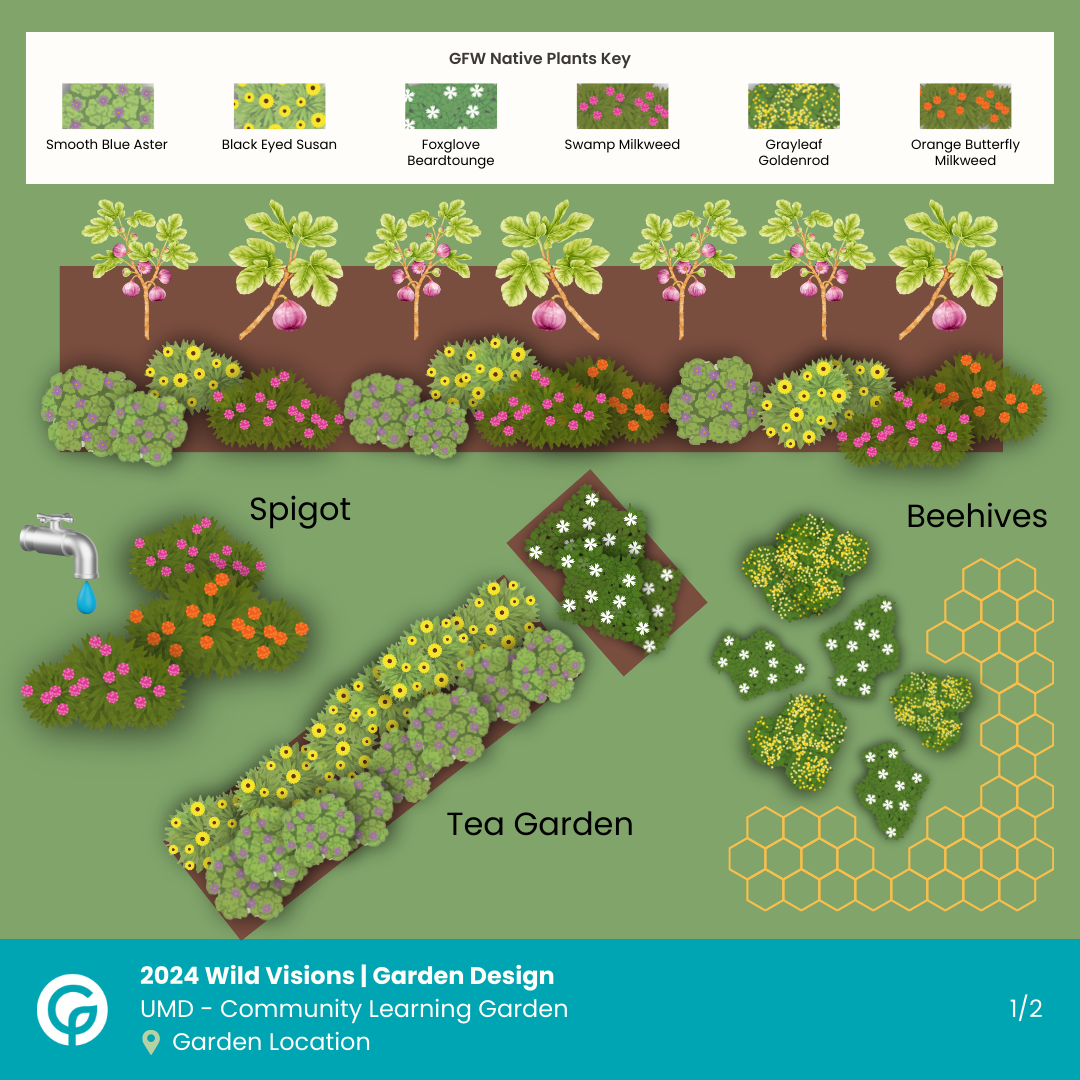We’ve got a wild vision - for a biodiverse future.
In this vision, people all around the country make a simple change with a big impact. They switch from planting non-native annuals (petunias, mums, pansies, etc.) to native perennials.

They begin to see caterpillars crawling along their plants, slumbering in chrysalises, and emerging as butterflies. Bees and birds frequent their yards - perhaps even toads and bunnies. Some folks will begin to shrink their lawn, replacing it with native grasses and shrubs that provide food and habitat, sequester carbon, and support local watersheds.
Neighbors walk past and see a yard teeming with life, with beautiful native plants from spring through fall, and perhaps a Certified Wildlife Habitat sign nestled in amongst the flowers. They’re inspired to garden for wildlife in their own yards, and surprised to find out that the switch helps them to save money and time in the long run. No need to repurchase flowers each spring, apply fertilizer and pesticides, and endlessly water. Instead, these flowers naturally return stronger each year - and so does the wildlife.
Slowly but surely, insect and butterfly populations return to stable levels. Chickadees have enough caterpillars to feed their young. We reverse the loss in songbirds, and monarchs triumphantly fill our skies each fall. With the foundation of native vegetation restored, local ecosystems regain their resilience and can adapt to the changing climate.
To achieve this vision, we have built a top-notch engine for people-powered biodiversity renewal: Garden for Wildlife. We took the country’s leading educational program for backyard conservation and turned it into an online native plant store, through which people can both learn about the importance of native plants and have botanist-curated collections shipped right to their door. We make it easy for people to make a difference by planting the right plants.
![]()
But we didn’t stop there. There is a critical piece to this engine that doubly accelerates biodiversity renewal: our Plant Bank. For each plant purchased, Garden for Wildlife donates one to a public restoration project - meaning that our customers do not only create habitat in their backyard, but in parks, schools, and wilderness areas all across the country. With this powerful mechanism, we are able to double our collective ecological impact - and invest in our own innovative community rewilding programs, like Wild Visions.
This spring, Garden for Wildlife launched our first annual Wild Visions Habitat Creation Challenge, challenging university students in the Washington DC area to design and plant native gardens in their communities. Fourteen student groups, from seven different universities, answered the call and spent the semester developing their garden concepts and designs with community partners.
We’ve just received their designs in anticipation of the late-April garden plantings - and we’ve been thoroughly blown away by their creativity.
Each group will receive a donation of 150 native flowering plants from Garden for Wildlife’s Plant Bank: smooth blue aster, grayleaf goldenrod, orange butterfly milkweed, swamp milkweed, foxglove beardtongue, and black-eyed susan. These plants, all native to the DMV, will attract a wide range of butterflies, native bees, and beneficial insects. Despite receiving the same plants, the students have created entirely unique gardens.

The Students for Indigenous and Native American Rights (SINAR) at George Washington University have designed a turtle-shaped native garden with Piscataway land stewards at the Accokeek Foundation. “We originally wanted to do something that would honor the Piscataway stewards of the land, and so the first thing that came to mind was the Piscataway Nation’s flag,” says Riya Sharma, co-president of SINAR. “The flag is colorful and features a turtle, which is a common motif in Indigenous North American symbolism and creation stories.” Their turtle garden includes foxglove beardtongue legs and shell made of aster and milkweeds.

Pollinator Pathway leading to the Community Learning Gardencaption that describes the image.

Pollinator Pathway leading to the community learning gardenthe image.

Community Learning Garden enhanced with native plants

Community Learning Garden enhanced with native plants
Three clubs at the University of Maryland have combined their Wild Visions to create a pollinator pathway leading up to the campus garden. Together, the Audubon Student Chapter, 17 for Peace and Justice, and Community Learning Garden have revived a relatively barren area and unused walkway to create an educational and relaxing inter-species space on campus. They plan to incorporate bird houses, bee cups and informational signage “that supports a variety of goals and interests of our shared collaborative efforts, such as environmental justice, avian conservation, and sustainable garden infrastructure.” The walkway leads right to the Community Learning Garden.

Photo Credit: Washington Parks and People
Both the Georgetown Outdoors club and Howard Revolt club partnered with Washington Parks and People to create pollinator habitat at the Columbia Heights Green Community Farm and Marvin Gay Park, respectively. Deja Daniel, president of Revolt, says they plan to continue their work in at Marvin Gay Park next year by “hosting educational workshops, providing a space for community gatherings, and collaborating with local schools.” Additionally, the increased pollinator presence in these gardens will support the urban agriculture taking place there.
There are many more unique and impactful gardens being developed through Wild Visions, and we will feature them all on our Instagram this month. Be sure to follow along, because we will need your help voting for the best garden!
All gardens will be planted during Earth Week (April 20-28), resulting in a total of over 5,000 square feet of new wildlife habitat in the DMV. Beyond habitat, Wild Visions will produce another critical resource: eco-agency. In participating in Wild Visions, students engage with the biodiversity crisis as an invitation to creativity and community care. They transform a small piece of this world for the better, and they’ll be able to witness the impact of that transformation for years to come.
At the community level, Wild Visions will help to green DC’s urban ecology, producing a plethora of documented public health benefits, from stress reduction to better learning outcomes in schools. The gardens will also serve as spaces for humans to connect with the natural world, and studies show that people who spend time in nature are more likely to step up as stewards and defenders of the land. At a time when the fate of the planet depends upon our ability to develop an expanded sense of care for the more-than-human world, restoring our connection with nature is of utmost importance.
We hope to demonstrate through Wild Visions just how much positive environmental impact people can have when they work collectively and imaginatively. We will need more programs of this sort to catalyze an effective cultural response to the biodiversity crisis and create a thriving future for all. That’s what’s so exiting about Garden for Wildlife: the more plants that are purchased through our site, the more plants we can donate to public biodiversity-renewal programs like Wild Visions.
And we’re just getting started.
